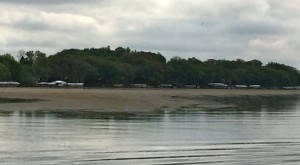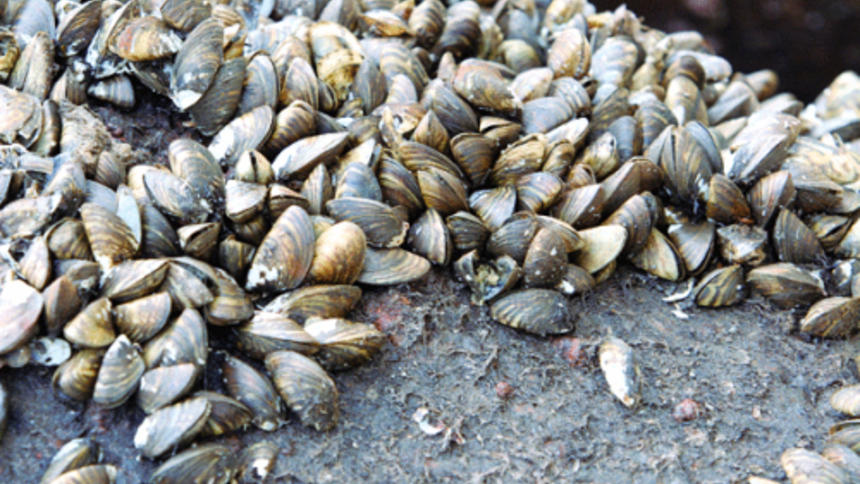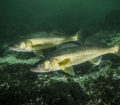By Steve Weisman

(photo by Steve Weisman): Much of the north end of East Okoboji is rimmed with curly-leaf pondweed. A cool water plant, it starts growing even under the ice, but by the end of June to early July, it begins to die off.
Say the words “water” and “exotic” and right away we think of zebra mussels, bighead carp and Eurasian watermilfoil. However, exotics cover so much more than that. In our Iowa Great Lakes chain, we have other exotics that are now part of these bodies of water. One of them, which seems to be more noticeable both last year and this year is curly-leaf pondweed.
Although it is in all of the lakes, it seems to be more obvious on East Okoboji. I noticed it a year ago about this same time, in the portion of the lake north of Highway 9 Bridge. This year, however, it is showing up to the south of the bridge extending to the Narrows.
According to DNR Fisheries Biologist Mike Hawkins, “It has been in the Iowa Great Lakes for decades, but it is more noticeable when the spring weather is cool and the water conditions are clear.” These two conditions make the perfect growing environment for this plant.
It is a cool water plant and starts growing even under the ice. By the end of June to early July, it begins to die off. On a positive note, Hawkins notes that it provides habitat for young bluegills, crappie, and yellow perch. “These tiny fish use the beds of plants as nursery habitat. The thick stands provide food and escape cover from predators.”
However, it is still an exotic, and it can out-compete native aquatic plants, because it starts growing so early. The dense stand we now have can definitely cause issues for anglers, swimmers and boaters. At the same time, people with their boats and personal watercraft often spread curly-leaf pondweed to other areas. Curly-leaf clings to boats, motors and trailers. With our helping hand, it can make it to other water bodies.
Curly-leaf growing season
The plant’s unique life cycle is what gives it an advantage over many of our native aquatic plants. It actually becomes active during late ice conditions, so it is up and going shortly after ice-out. As mentioned earlier, it begins to die back by early to mid-July, but, unfortunately, these die-offs can lead to depleted oxygen conditions and mats of decaying plant material washing up on shorelines. With the increase in nutrients can often come a blue-green algae bloom. Known as cyanobacteria, blue-green algae can be pretty ugly and stinky.
Can it be controlled? Researchers have tried a lot of methods and work in this area is ongoing, but there has been little success. According to Hawkins, “Aquatic herbicides can provide some control, but their use can be expensive and problematic in public waters, especially those associated with drinking supplies like we have here in the Iowa Great Lakes. Private pesticide application in public water bodies is illegal and strictly controlled. Mechanical removal or cutting can be a solution for homeowners around docks and boat hoists. This can be done without a permit as long as state rules are followed.”
So, what now?
Curly-leaf pondweed is here, and it’s not going away. However, we can’t just throw in the towel and give up. It is a human problem: humans have introduced so many of our exotics into our waters. That’s why we have the laws and the enforcement we have for exotics. There are so many more exotics out there that could enter the Iowa Great Lakes if we do not maintain our diligence. Can you imagine if several more were to get into the system? What damage would be done then?
Being an old coach, I always believe this: never give up. Never throw in the towel. In this instance, our natural resources, even when they have been somewhat compromised, are way too important for us to just give up.
The answer is the same as it has always been when we spend time on the water. Always check for and remove plants, mud and debris from boats, trailers, clothing, and equipment before leaving a water body. Drain all water from bait buckets, bilges, and live wells before transporting to new waters. Clean all gear and equipment with hot water or let boats and equipment dry thoroughly for several days before entering a new body of water.


















